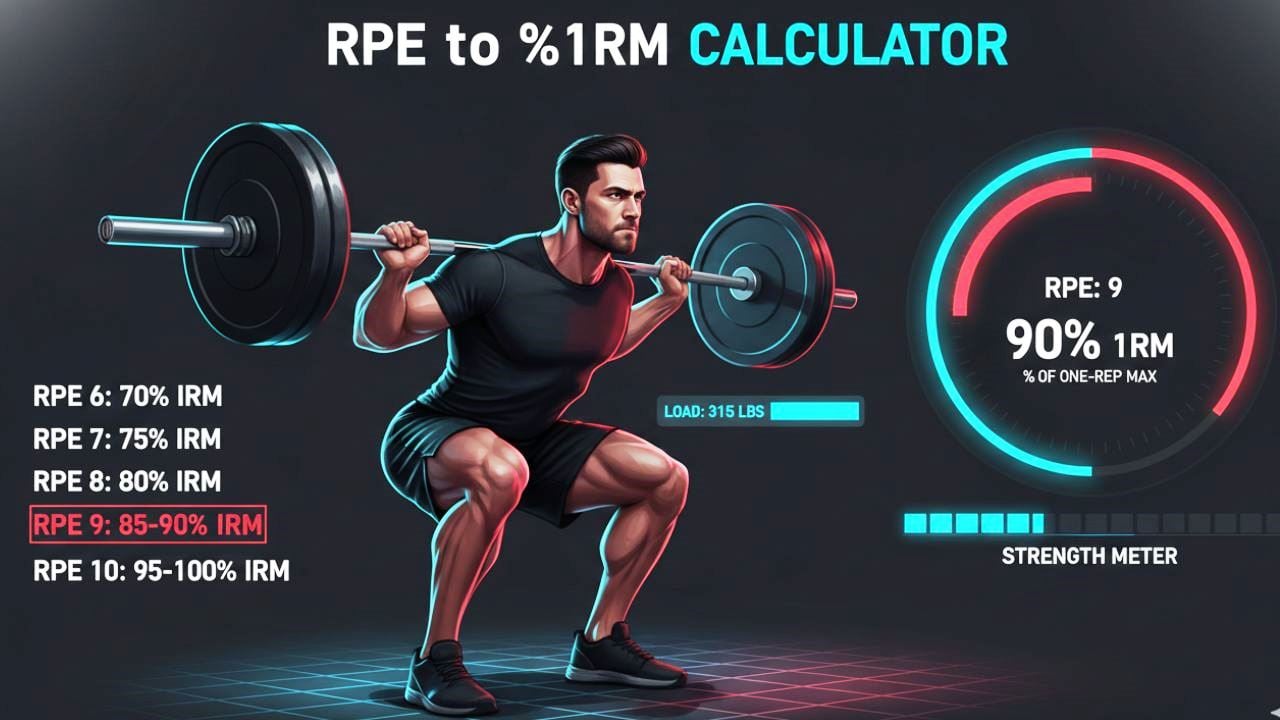🎯 RPE to %1RM Calculator
Convert between RPE and percentage of 1RM with exercise-specific precision for smarter training programming

What is RPE, 1RM, and %1RM?
RPE measures how hard a set feels on a 1-10 scale. Instead of guessing weights, you rate difficulty based on how many more reps you could do. RPE 10 means you can’t do another rep. RPE 8 means you have 2 reps left. This approach, called Reps in Reserve (RIR), lets you adjust training based on daily energy levels.
Developed by Mike Tuchscherer, RPE works for any exercise—bench press, squats, or curls. On strong days, RPE 8 might be heavier weight. On tired days, you use lighter weight for the same RPE. This prevents overtraining while maximizing progress.
What is 1RM (One-Rep Maximum)?
Your 1RM is the heaviest weight you can lift for exactly one repetition with good form. For example, if 300 lbs is the most you can bench press once, that’s your bench press 1RM. This number helps you plan training loads for building strength and muscle.
Testing 1RM frequently is tiring and risky. That’s why we use percentages instead. If your 1RM is 300 lbs and you train at 80%, you’d use 240 lbs. Different percentages create different training effects: 90%+ builds max strength, 75-85% builds strength and size, below 70% builds endurance.
Understanding %1RM (Percentage of One-Rep Max)
%1RM tells you what portion of your maximum you’re lifting. At 100% (your 1RM), you can do 1 rep. At 85%, you might do 4-6 reps. At 70%, you could do 10-12 reps. This percentage directly links to how many reps you can perform at that weight.
The magic happens when you combine %1RM with RPE. Instead of saying “do 5 reps at 80%,” coaches now say “do 5 reps at RPE 8.” Both target similar intensity, but RPE adjusts to your daily readiness. This calculator bridges both worlds, converting between RPE and %1RM instantly.
| RPE | Reps Left | How It Feels | When to Use |
|---|---|---|---|
| 10 | 0 | Maximum effort, can’t do more | Testing max, competitions only |
| 9 | 1 | Extremely hard, maybe 1 more | Heavy singles, peaking phase |
| 8 | 2 | Very challenging, 2 more reps | Main working sets, strength work |
| 7 | 3 | Hard but controlled, 3 left | Volume days, muscle building |
| 6 | 4+ | Manageable, plenty left | Warm-ups, technique work |
The Science Behind RPE-to-%1RM Conversion
If you complete 5 reps at RPE 8 (2 reps in reserve):
• Maximum reps to failure = 5 + 2 = 7 reps
• A 7-rep maximum correlates to approximately 80% of 1RM
• Therefore: 5 reps @ RPE 8 = 81% of 1RM
• This is accurate based on established RPE research
1️⃣ From chart: 5 reps @ RPE 8 = 81% of 1RM
2️⃣ Calculate load: 300 lbs × 0.81 = 243 lbs
3️⃣ Use 245 lbs for your working sets
When you complete 5 reps with 245 lbs and feel you have exactly 2 more reps left, you’ve hit your target RPE perfectly!
Research Validation
Studies in the Journal of Strength & Conditioning Research demonstrate that trained individuals can accurately assess their RPE within 0.5-1.0 points of actual proximity to failure. This self-regulation capability makes RPE an effective tool for managing training intensity without constant 1RM testing.
For comprehensive RPE training resources and scientifically validated calculators, RPE Training provides extensive tools with 0.80-0.90 correlation to physiological markers, covering strength training, powerlifting, and cardio applications.
Research also shows that different exercises have unique fatigue patterns, which is why this calculator includes exercise-specific adjustments for compound movements like squats, deadlifts, and bench presses versus isolation exercises.
⚕️ Important Disclaimer
This RPE to %1RM Calculator provides estimates based on established strength research and Mike Tuchscherer’s RPE methodology. Individual responses vary based on training experience, exercise proficiency, muscle fiber composition, and daily readiness. The calculations represent population averages and may not perfectly match your individual RPE-to-intensity relationship. Beginners should expect less accurate self-assessment initially, with skill improving over 3-6 months of consistent practice. Always prioritize proper form over weight increases, and consult qualified strength coaches or healthcare professionals before beginning any new training program, especially if you have pre-existing injuries or medical conditions. These calculations are for educational and training guidance purposes only.

Manish is a NASM-certified fitness and nutrition coach with over 10 years of experience in weight lifting and fat loss fitness coaching. He specializes in gym-based training and has a lot of knowledge about exercise, lifting technique, biomechanics, and more.
Through “Fit Life Regime,” he generously shares the insights he’s gained over a decade in the field. His goal is to equip others with the knowledge to start their own fitness journey.
